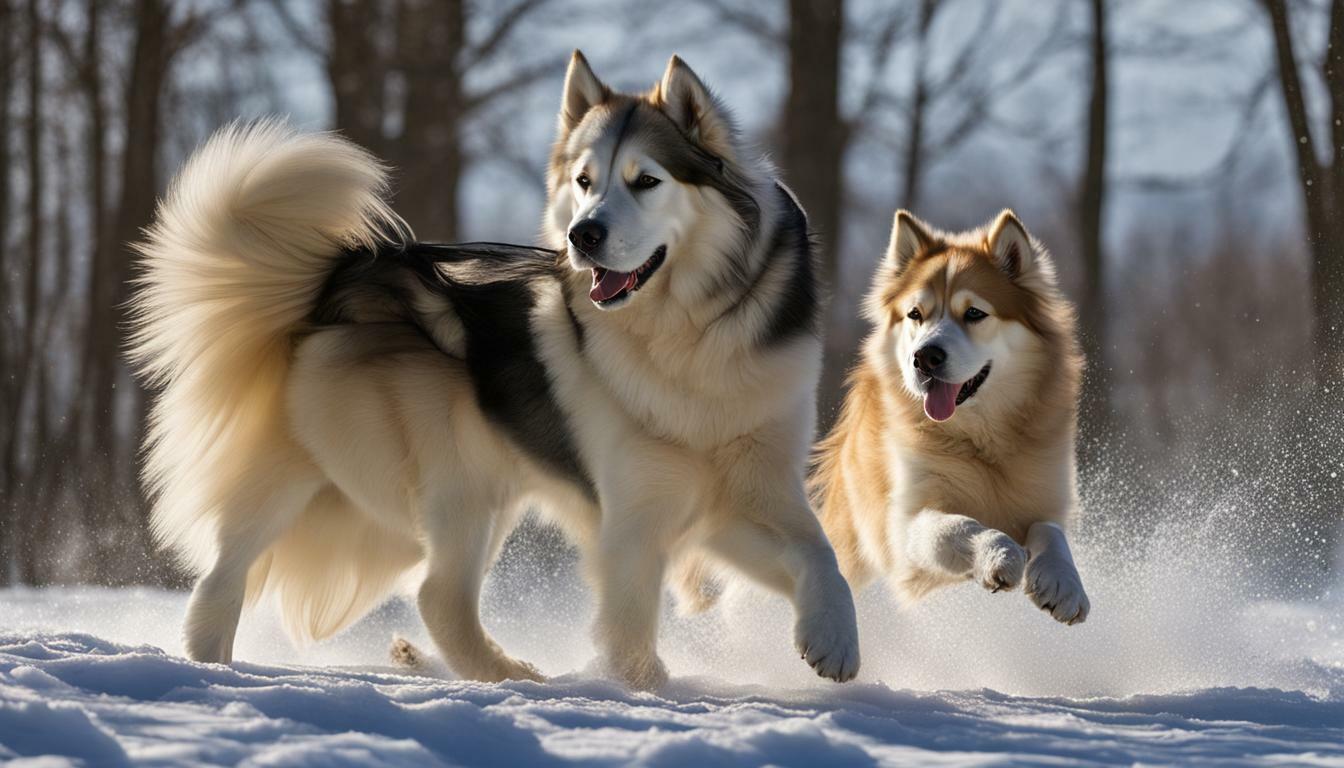Choosing between an Alaskan Malamute and a Golden Retriever as your perfect pet requires careful consideration of their characteristics and suitability to your needs.
When it comes to comparing these two popular dog breeds, it’s important to understand their individual traits and care needs to make an informed decision. In this article, we will delve into the key differences between Alaskan Malamutes and Golden Retrievers, helping you determine which breed is best suited for you.
Both Alaskan Malamutes and Golden Retrievers have their unique qualities and considerations. By exploring their distinct characteristics, such as temperament, size, grooming needs, exercise requirements, and trainability, you’ll gain valuable insights into which breed aligns with your preferences and lifestyle.
Throughout this article, we will provide you with detailed information on each breed’s traits and care needs, shedding light on their strengths and weaknesses. By considering factors like your living environment, activity level, and family dynamic, you can determine whether an Alaskan Malamute or a Golden Retriever is the best fit for you.
So, without further ado, let’s dive into the fascinating world of Alaskan Malamutes and Golden Retrievers, and explore the factors that will help you choose your perfect pet.
Alaskan Malamute Traits and Care Needs
Alaskan Malamutes are known for their friendliness and love for human interaction, but they also possess certain traits and care needs that should be taken into account. These majestic dogs are highly social and thrive on human attention, making them excellent companions. However, their independent and strong-willed nature requires consistent training and early socialization.
One important aspect of caring for an Alaskan Malamute is understanding their high prey drive. These dogs have an innate instinct to chase and hunt, which can be a challenge in certain situations. It’s crucial to provide them with ample physical and mental stimulation to redirect their energy in a positive way. Regular exercise, interactive toys, and engaging activities will help keep them content and prevent destructive behaviors.
Additionally, Alaskan Malamutes are athletic dogs that require daily exercise to stay healthy and happy. They have a natural inclination for pulling, which makes activities like sledding or carting suitable for them. Long walks, hikes, and play sessions in a secure area are also essential to meet their exercise needs. Remember to always keep them on a leash or in a fenced yard, as their strong prey drive might lead them to chase after small animals.
| Traits | Care Needs |
|---|---|
| Highly social and friendly | Requires consistent training and early socialization |
| Strong prey drive | Needs ample physical and mental stimulation |
| Athletic and energetic | Requires daily exercise and activities |
Understanding these unique traits and care needs is crucial when considering Alaskan Malamutes as your potential pet. While they make loyal and affectionate companions, they require dedication and commitment to ensure their well-being. With proper training, socialization, and an active lifestyle, Alaskan Malamutes can thrive in a loving home and bring endless joy to their owners.
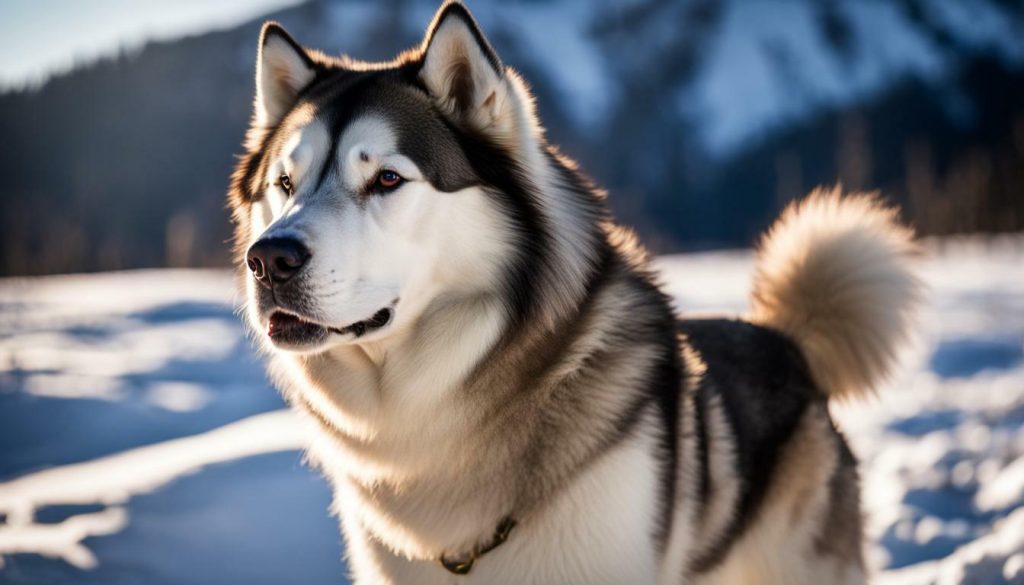
Golden Retrievers exhibit certain traits and have unique care needs that make them a popular choice for families and individuals alike. These lovable dogs are known for their intelligence, friendly nature, and easy trainability. When considering a Golden Retriever as a pet, it’s essential to understand their characteristics and the care they require.
First and foremost, Golden Retrievers are highly intelligent dogs. They have a natural eagerness to please their owners, which makes them incredibly trainable. Whether you’re teaching them basic commands or more advanced tricks, they are known to pick up new skills quickly.
Another standout trait of Golden Retrievers is their friendly and gentle nature. They are excellent companions for children and tend to get along well with other pets. However, proper socialization and training from an early age are essential to ensure they develop into well-behaved and sociable dogs.
In terms of care needs, Golden Retrievers require regular exercise to keep them physically and mentally stimulated. They are active dogs that enjoy outdoor activities, such as long walks, runs, or playing fetch. Providing them with enough physical exercise will help prevent behavioral problems, as they can become anxious or destructive if not adequately exercised.
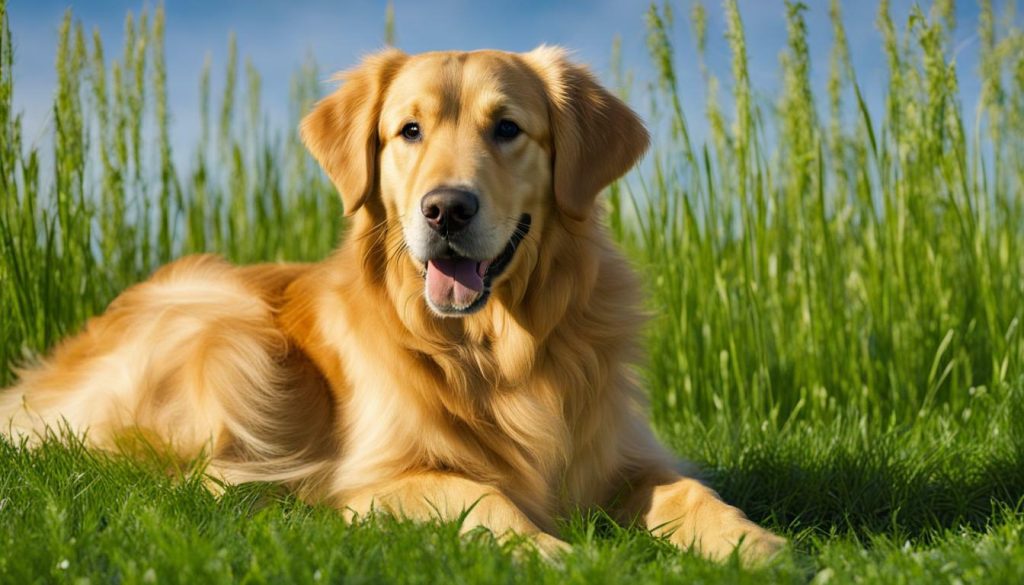
When it comes to grooming, Golden Retrievers have a dense double coat that requires regular brushing to prevent matting and to keep their fur in good condition. They are moderate shedders throughout the year, with heavier shedding occurring during seasonal coat changes. Regular grooming will help minimize loose hair in your home.
In conclusion, Golden Retrievers make wonderful pets due to their intelligence, friendly nature, and adaptability. They require regular exercise, socialization, and proper grooming to thrive. If you’re looking for a loyal and affectionate companion, a Golden Retriever might be the perfect choice for you and your family.
Size and Physical Characteristics
When considering Alaskan Malamutes and Golden Retrievers, it’s important to note the differences in their size and physical appearance. Alaskan Malamutes are a large breed, typically weighing between 75 to 100 pounds and standing 23 to 25 inches tall at the shoulder. They have a sturdy and powerful build, with a broad head and erect ears. Their thick double coat provides insulation and protection from harsh weather conditions.
Golden Retrievers, on the other hand, are slightly smaller in size. They typically weigh between 55 to 75 pounds and stand 21.5 to 24 inches tall at the shoulder. They have a well-balanced and muscular build, with a friendly expression and a thick, water-repellent coat that comes in various shades of gold.
To visualize the differences, take a look at the table below:
| Breed | Average Weight | Average Height |
|---|---|---|
| Alaskan Malamute | 75-100 pounds | 23-25 inches |
| Golden Retriever | 55-75 pounds | 21.5-24 inches |
These size and physical characteristics play a role in determining the space and exercise requirements for each breed. Alaskan Malamutes, being larger and more energetic, need ample space to roam and regular exercise to prevent boredom and frustration. Golden Retrievers, although slightly smaller, still require plenty of exercise to maintain their physical and mental well-being.
Ultimately, it’s essential to consider your living arrangements, available space, and ability to meet the exercise needs of a particular breed when making a decision between an Alaskan Malamute and a Golden Retriever.
Shedding and Grooming Needs
Both Alaskan Malamutes and Golden Retrievers have specific shedding patterns and grooming needs that should be taken into account when deciding on a pet. Alaskan Malamutes have a thick double coat that keeps them well-insulated in cold temperatures. However, this also means that they shed heavily, especially during seasonal changes. Regular brushing is essential to maintain their coat and minimize loose hair around the house.
Golden Retrievers, on the other hand, have a dense, water-repellent outer coat and a soft undercoat. They also shed, but not as excessively as Alaskan Malamutes. Regular brushing is still necessary, especially during shedding seasons.
Both breeds benefit from a bath every few months to keep their coat clean and healthy. Additionally, their ears should be regularly checked and cleaned to prevent infections. Nail trimming is also essential to prevent overgrowth and discomfort.
Shedding and Grooming Comparison:
| Breed | Shedding | Grooming Needs |
|---|---|---|
| Alaskan Malamute | Heavy shedding | Regular brushing, occasional bathing |
| Golden Retriever | Moderate shedding | Regular brushing, occasional bathing |
In conclusion, if you are considering an Alaskan Malamute or a Golden Retriever as your ideal pet, it is important to be aware of their shedding patterns and grooming needs. Both breeds require regular brushing and occasional bathing. However, Alaskan Malamutes shed heavily, so be prepared for more frequent vacuuming and grooming sessions. Golden Retrievers, although they shed moderately, still require attention to their coat to keep it healthy and free from mats. By understanding and considering their shedding and grooming requirements, you can make an informed decision that best suits your lifestyle and preferences.
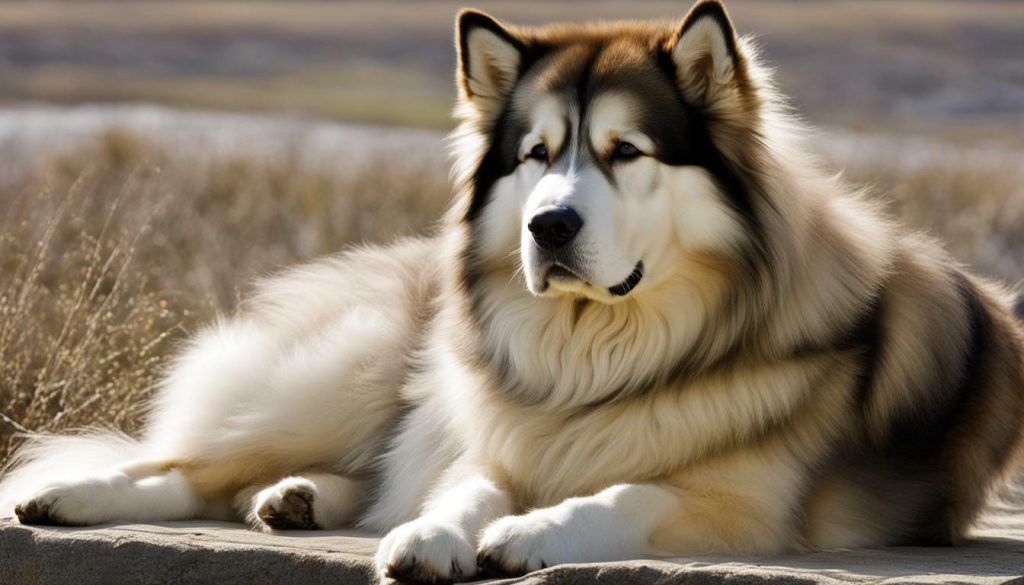
Providing adequate exercise and activity is crucial for the health and well-being of both Alaskan Malamutes and Golden Retrievers. These breeds have different needs when it comes to physical activity, so it’s important to understand their requirements to ensure a happy and healthy lifestyle for your pet.
The Alaskan Malamute is a highly active and energetic breed. They have a strong instinct to pull and run, making them well-suited for activities such as sledding, carting, and even competitive sports like agility. Daily exercise is essential for these dogs, and they thrive in environments where they have plenty of space to roam and explore. A long daily walk, coupled with ample playtime and mental stimulation, will help keep your Alaskan Malamute physically and mentally stimulated.
Golden Retrievers are also active dogs that require regular exercise. They enjoy activities such as swimming, playing fetch, and going for long walks or hikes. These friendly and sociable dogs thrive on interaction with their owners and other animals, so incorporating activities that involve interaction and play is important for their well-being. Golden Retrievers are highly adaptable and can adjust to various living environments, making them suitable for both urban and rural settings.
Exercise Guidelines
To meet the exercise needs of both breeds, here are some general guidelines:
| Alaskan Malamute | Golden Retriever |
|---|---|
| At least 60-90 minutes of exercise per day | At least 30-60 minutes of exercise per day |
| Activities that provide both physical and mental stimulation | Activities that involve interaction and play |
| Use puzzle toys or games to challenge their problem-solving skills | Incorporate swimming or retrieving exercises |
Remember, exercise requirements can vary based on factors such as age, health, and individual temperament. It’s crucial to consult with your veterinarian and consider your specific circumstances when determining the exercise routine that best suits your Alaskan Malamute or Golden Retriever.
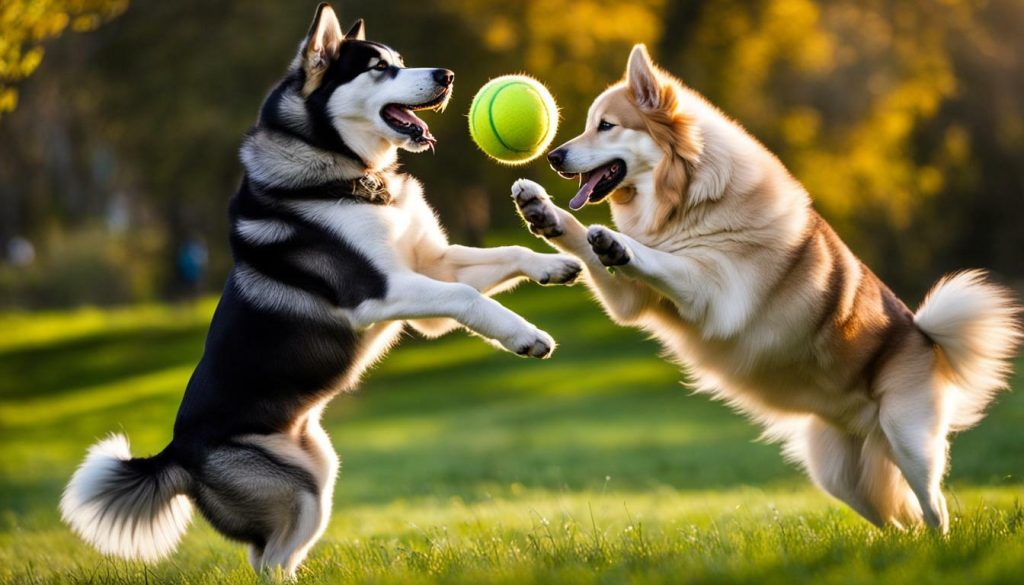
“Regular exercise not only keeps your dog physically fit but also contributes to their mental well-being. It helps prevent behavioral issues such as boredom-induced destructiveness and excessive barking. A tired dog is a happy dog!” – Dr. Jane Smith, Veterinarian
Intelligence and Trainability
Both Alaskan Malamutes and Golden Retrievers are known for their intelligence and trainability, but there may be differences in their learning styles and ease of training. Alaskan Malamutes are highly intelligent dogs that possess problem-solving skills, making them excellent at figuring out puzzles and finding ways to get what they want. However, their independent nature and strong-willed behavior can sometimes make them a bit more challenging to train compared to Golden Retrievers.
Golden Retrievers, on the other hand, are renowned for their eagerness to please and their love for learning. They are quick learners and are usually very responsive to positive reinforcement training methods. Their intelligence, coupled with their friendly and patient nature, makes them a popular choice for obedience and agility competitions. Golden Retrievers are also typically more adaptable to different training styles, making them a bit easier to train than Alaskan Malamutes.
| Intelligence | Alaskan Malamute | Golden Retriever |
|---|---|---|
| Problem-solving skills | High | Moderate |
| Ease of learning | Moderate | High |
| Trainability | Challenging | Relatively easy |
Alaskan Malamutes can be a bit stubborn at times, so it’s important to establish yourself as the pack leader and use consistent, positive reinforcement techniques during training. On the other hand, Golden Retrievers are known for their eager-to-please attitude, making them more responsive to training and easier to handle overall.
When it comes to intelligence and trainability, it ultimately depends on your own training skills and the time and effort you’re willing to invest in your furry friend. Both Alaskan Malamutes and Golden Retrievers can excel in obedience training and learn a wide range of commands, but their individual personalities and learning styles may require different approaches.
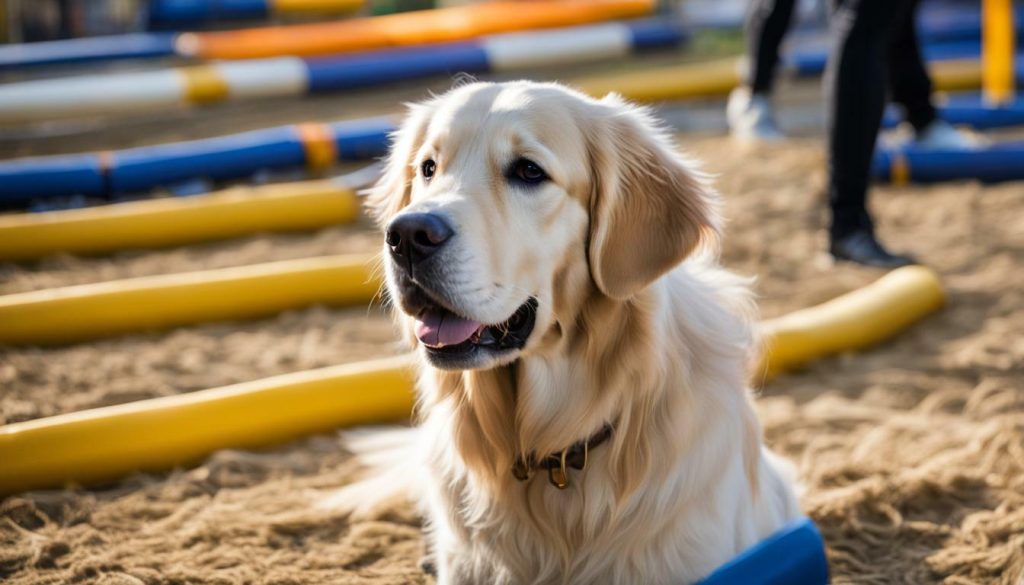
Suitability as Family Dogs
Alaskan Malamutes and Golden Retrievers are often considered as great family pets, but there are specific factors to consider when choosing the best breed for your family. Alaskan Malamutes are known for their friendliness and love for human attention, making them affectionate companions for the whole family. However, they can also be strong-willed and have a high prey drive, which means they may not be the best choice if you have small pets at home. Additionally, Alaskan Malamutes thrive as the only dog in the household, as they may display dominance towards other dogs.
On the other hand, Golden Retrievers are intelligent, friendly, and extremely patient, making them excellent choices for families with children. They are known for their gentle nature and ability to get along well with kids of all ages. Golden Retrievers also have a lower prey drive compared to Alaskan Malamutes, which makes them less likely to chase after small animals.
When it comes to adaptability, Golden Retrievers tend to be more versatile than Alaskan Malamutes. They can easily adapt to different living environments, making them suitable for both urban and rural settings. Alaskan Malamutes, on the other hand, are more suited to households with larger yards or access to outdoor spaces where they can run and play.
Table 1: Alaskan Malamute vs. Golden Retriever – Suitability as Family Dogs
| Breed | Friendliness | Prey Drive | Compatibility with other pets | Adaptability |
|---|---|---|---|---|
| Alaskan Malamute | High | High | Best as only dog | Suited to larger yards or outdoor spaces |
| Golden Retriever | Very high | Low | Great with other pets | Adaptable to various living environments |
Ultimately, choosing between an Alaskan Malamute and a Golden Retriever as a family pet depends on your lifestyle, living situation, and the specific needs of your family. Consider factors such as the size of your home, the amount of exercise you can provide, and the presence of other pets. Both breeds offer unique qualities and can bring immense joy and love to a family, but it’s essential to make an informed decision that aligns with your family’s preferences and requirements.

*Table data is based on general breed characteristics and may vary for individual dogs.*
Understanding the potential health issues and lifespan of Alaskan Malamutes and Golden Retrievers is an important aspect of responsible pet ownership. Both breeds are generally healthy, but they do have some breed-specific health concerns to be aware of.
| Breed | Common Health Issues | Average Lifespan |
|---|---|---|
| Alaskan Malamute | Hip dysplasia, progressive retinal atrophy, and chondrodysplasia | Around 10-14 years |
| Golden Retriever | Hip dysplasia, elbow dysplasia, and certain types of cancers | Around 10-12 years |
Regular veterinary check-ups, a balanced diet, and exercise are essential for maintaining the health of both breeds. Additionally, early detection and treatment are crucial in managing any potential health issues.
While Alaskan Malamutes are generally prone to fewer health issues than Golden Retrievers, they have a higher risk of hip dysplasia and chondrodysplasia. Golden Retrievers, on the other hand, have a higher risk of certain types of cancers, such as lymphoma and hemangiosarcoma. Responsible breeders can help reduce the risk of these health issues by performing health screenings on their breeding dogs.
It is important to note that individual dogs may vary, and not every dog will be affected by these health issues. Providing a nutritious diet, regular exercise, and proper veterinary care can help ensure that your Alaskan Malamute or Golden Retriever lives a long, happy, and healthy life.
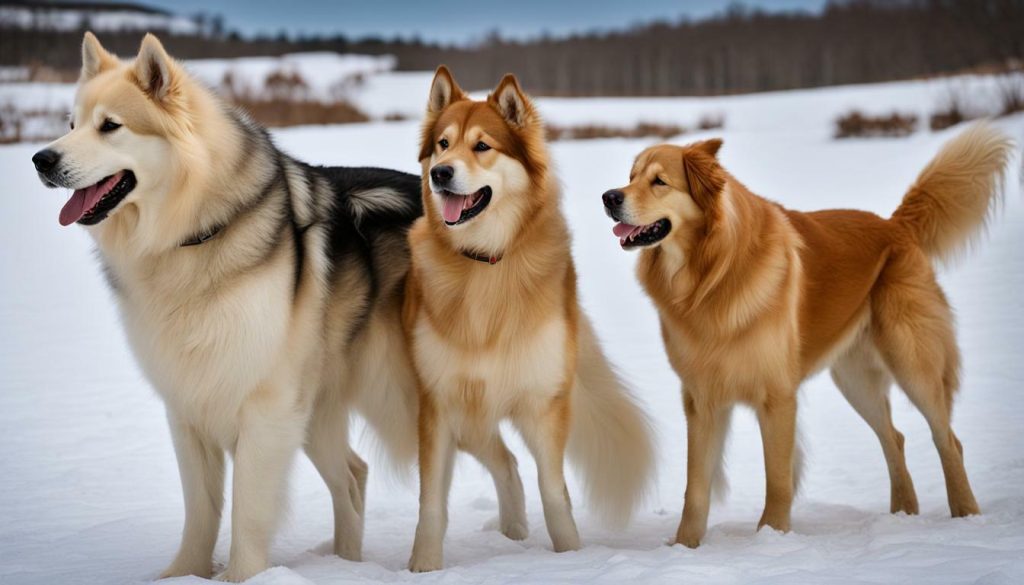
By weighing the pros and cons of owning an Alaskan Malamute or a Golden Retriever, you can make a well-informed decision and choose the perfect pet for your needs.
Alaskan Malamutes are known for their friendliness and love for human attention. They are affectionate companions who thrive in a family environment. However, these majestic dogs can also be strong-willed and have a high prey drive, which means they may require firm training and a secure environment. If you have experience with dog ownership and are willing to invest time and effort into training, an Alaskan Malamute can be a wonderful companion.
On the other hand, Golden Retrievers are highly intelligent and easy to train. They are known for their friendly and gentle nature, making them excellent family pets. With their lower prey drive and adaptability to different living environments, Golden Retrievers can fit well into various lifestyles. They are good with children and tend to have fewer health issues compared to some other breeds. If you are looking for a versatile, loyal, and loving companion, a Golden Retriever could be the best choice for you.
Ultimately, your decision should be based on your lifestyle, preferences, and the specific needs of each breed. Consider factors such as the size and physical characteristics, shedding and grooming needs, exercise and activity requirements, intelligence and trainability, suitability as family dogs, and health considerations. It’s important to note that both Alaskan Malamutes and Golden Retrievers have their unique traits and considerations. By doing thorough research and understanding what each breed offers, you can make a decision that will bring joy and companionship into your life for years to come.
FAQ
Q: What factors should I consider when choosing between an Alaskan Malamute and a Golden Retriever?
A: When choosing between these breeds, factors to consider include their traits, care needs, size, shedding and grooming requirements, exercise and activity needs, intelligence and trainability, suitability as family dogs, and health considerations.
Q: Are Alaskan Malamutes friendly?
A: Yes, Alaskan Malamutes are generally friendly and thrive on human attention.
Q: Do Alaskan Malamutes have a high prey drive?
A: Yes, Alaskan Malamutes can have a high prey drive, which means they may be prone to chasing small animals.
Q: Can Alaskan Malamutes get along with other dogs?
A: Alaskan Malamutes are best as the only dog in the household and may not get along well with other dogs.
Q: Are Alaskan Malamutes athletic and enjoy outdoor activities?
A: Yes, Alaskan Malamutes are athletic and enjoy outdoor activities such as running and hiking.
Q: Are Alaskan Malamutes capable problem-solvers?
A: Yes, Alaskan Malamutes are known to be capable problem-solvers and require mental stimulation.
Q: Are Golden Retrievers easy to train?
A: Yes, Golden Retrievers are intelligent, friendly, and easy to train.
Q: Are Golden Retrievers good with kids?
A: Yes, Golden Retrievers are generally good with kids and are known for their friendly and gentle nature.
Q: Do Golden Retrievers have a lower prey drive compared to Alaskan Malamutes?
A: Yes, Golden Retrievers generally have a lower prey drive compared to Alaskan Malamutes.
Q: Are Golden Retrievers adaptable to different living environments?
A: Yes, Golden Retrievers are more adaptable to different living environments compared to Alaskan Malamutes.
Q: Do Golden Retrievers have fewer health issues compared to Alaskan Malamutes?
A: Yes, Golden Retrievers tend to have fewer health issues compared to Alaskan Malamutes.
Q: What are the pros and cons of owning an Alaskan Malamute or a Golden Retriever?
A: The decision ultimately depends on your preferences and lifestyle. Alaskan Malamutes are friendly and athletic but can have a high prey drive and require training from an early age. Golden Retrievers are easy to train, good with kids, and have a lower prey drive but may have more health issues. Consider these factors when making your decision.
